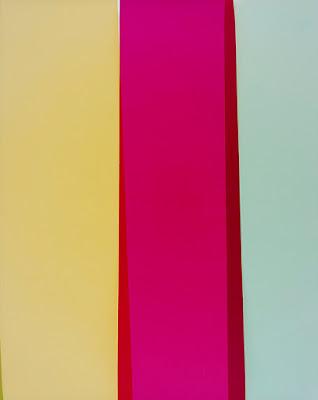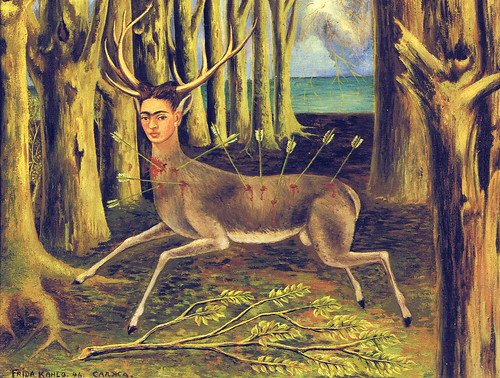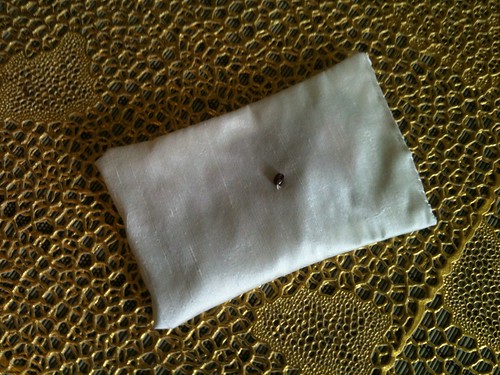
If Halloween is the time when the veils are thin between reason and fantasy, between the conscious and unconscious, this story is a most timely one. Who hasn’t dreamt of bringing their loved one back – from the dead, or from the oblivion where most relationships find themselves once they are over? Clarimonde is one such story, in which love cannot be fulfilled because of the dramatic dichotomy and differences between the two lovers. Yet, somehow, they manage to reunite… Clarimonde returns from the place where non ever came back after her death which Romuald witnessed; and Romuald finds a way to be with Clarimonde in the safe world of his dreams, where everything is possible and no one can truly be held accountable for their actions.
I tend to shy away from vampire literature and cinema, finding them either too frightful for me (I’m just now, in my 13th year in Canada, finally getting used to the idea of skeletons and skulls and faux blood being OK and maybe even of some aesthetic interest…), and at best bring to mind the pathos of mail-order-bride spam from Russia that I receive on a daily basis.
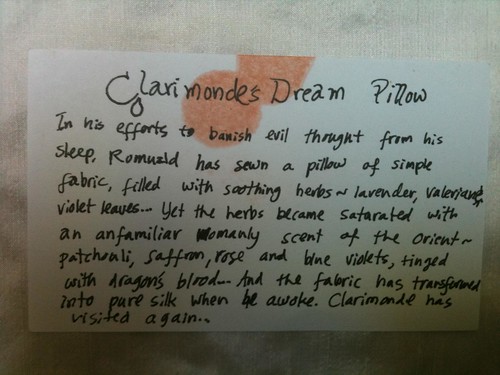
However, when learning about the Clarimonde project that Lucy Raubertas of
IndiePerfumes blog has initiated, I have first encountered a vampire story that was not frightening, but rather touching on a most personal level. Once completing the short story titled Clarimonde (by Theophile Gautier, which was published in 1836), I felt like it touched a nerve. It certainly helped that the vampire lady in it was not a blood-thirsty vixen, but rather a creature of light and beauty. There were no scary moments in the story to send chills down my spine either. And more important than what was not there that keeps me away from the vampire genre at large, was the depth of layers of meaning the story unfolded every time I read it again (and by now I read and listened to it 5 times…).
Clarimonde strongly resonated with me, thought at first I could not quite tell why or how, aside from its alarming resemblance to a
virtual love affair, in which the subject of one’s love cannot quite be part of their everyday life; yet takes a bigger-then-life form in the internal world of the lovers. It is an intangible yet very real experience, which seems to become more and more prominent in our day and age and is something I have been exploring in my Virtual Lover project.
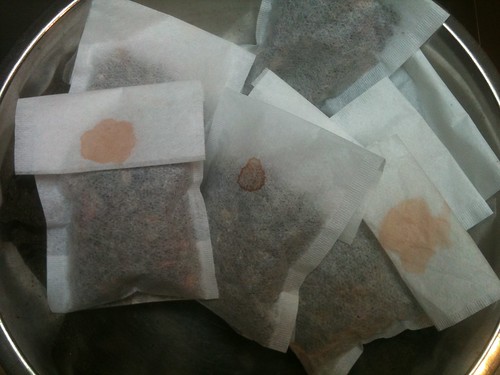
To me, the story of Clarimonde is that of love and betrayal. It is a story of a woman’s love so strong and her beauty so powerful that it concurs a man’s most sacred values and aspirations and shakes him to his core. It is also a story of a woman’s sacrifice – her health, her life, her innate nature – only to make one man happy… And the man turns to be a very ungrateful one. It is a story of loss, spoiling of perfection (I do see the dual life that Romuald lived as a balanced and beautiful solution to his difficult position); ruining something that is precious and pure only because it does not fit with dogma.
Yet, despite of Clarimonde’s sacrifice and how she changes for him (instead of taking other lovers and sucking their blood as she pleases, she only takes a few drops of his while doing everything to not hurt him and heal his little tiny puncture of a wound); despite all that, Romuald refuses to stand up to dogma and see that her love is, indeed, as pure as God’s and it is that love that makes her not truly cast away from humanity or from the divine’s love. Just as he can’t find the power within himself to say no to the vows on the day of his ordination and change his path, he passively lets Abbe Serapion cast Clarimonde into oblivion…
It is also, as Mandy Aftel pointed out in the process of us creating and sharing the thoughts and feelings that the story brought forth, a story of extremes that seemingly do not reconcile. The man telling the story, a European monk, goes from the extreme of ugly, mundane and colourless life of suffering, service, sanctity and sacredness by day to that of love, beauty, pleasure, abundance, opulence, desire and rich hues by night. The only thing that connects these two worlds is his sleep. So I have decided to focus on that part and see how these two worlds connect through perfume.
Therefore, I have decided to create a dream pillow for this project, rather than a traditional perfume. Dream pillows are little flat pillows that are filled with a sachet of herbs that should invite a restful sleep. The pillow is tucked inside your real pillow, and while moving in your sleep, the herbs release their sweet scent and sweetens your dreams…
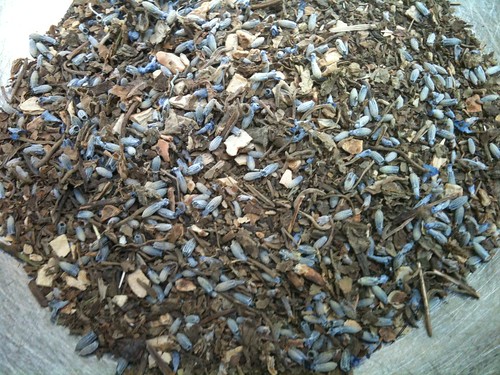
It was a fine overcast day last Saturday, and I finally completed sewing 7 dream pillows inspired by Clarimonde... They are all filled with a sachet of dried herbs that should invoke a restful sleep: valerian roots, violet leaf, lavender buds, and some orris root, patchouli leaves and rose buds for their scent and evocative colour of blood and passion.
These herbs, however, are perfumed by what is my interpretation of the "Oriental perfume" that lingers in Clarimonde's death chamber in the 2nd physical encounter between the lovers, the only one that is fulfilled (the first one being his sight of her in his day of his ordination, in which he rejects her and chooses God; and the last one is at her tomb, which is very grim). In this one, his love and sadness for her loss brings her back to life even if just for a few moments, in which they kiss and embrace, and a bond is created that makes their life inseparable for as long as 3 years…
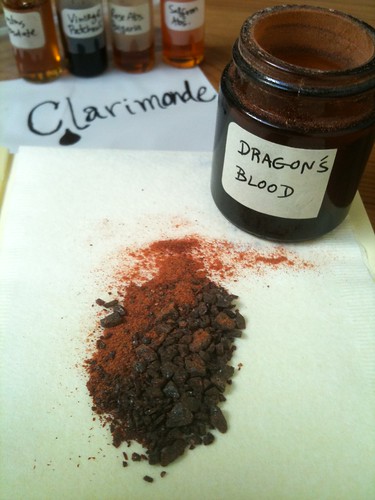
For the Clarimonde perfume, I decidedly chose essences that would build a classic and “typical” spicy-oriental; that which is heavy on the patchouli and eugenol (from cloves). But I also juxtaposed it with notes of flowers that are mentioned in the story: the blue violets in her hair, the red carnation of her lips, the white rose that symbolizes Clarimonde’s life at her chamber (it is not until the last petal falls that we know she is really, truly dead). These all took a life of their own as I read the story, with clear colours, textures and scents… The sensuality of Clarimonde is contrasted (and balanced) by the distance of her beauty and the coldness of her touch, which Raumald feels when she is alive at their first encounter at the church; and is no difference after her death. The story had very interesting palette of colours: mostly black and white, with splashes of colours on the appearance of Clarimonde, mostly of red and blue hues, and the blood is purple… There is only one thing that is yellow in the story: Clarimonde’s blond hair (or gold, as Romuald describes it).
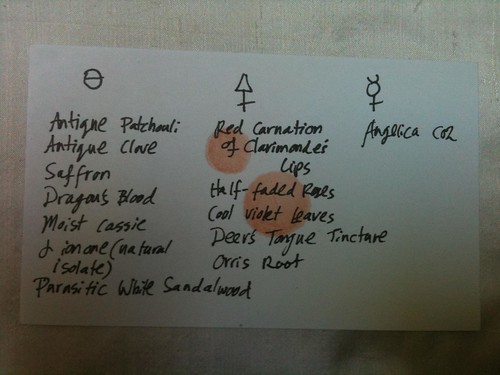
So, I have chosen notes that are warm and spicy, such as vintage patchouli and vintage cloves, saffron and carnation to portray the warmth; and a violet accord to bring the cold, moist element to the perfume. Aside from violet leaf and cassie (both very wet and cold smelling essences), I have also used the velvety, candied-violet note of alpha ionone – and this is my first time to use a natural isolate in a perfume. I chose this note not only because I wanted the violets to have a dominant presence; but also because there is something very pure, clear and surreal about this note, which reminds me of Clarimonde’s voice as she speaks to Romuald for the first time in his dream.
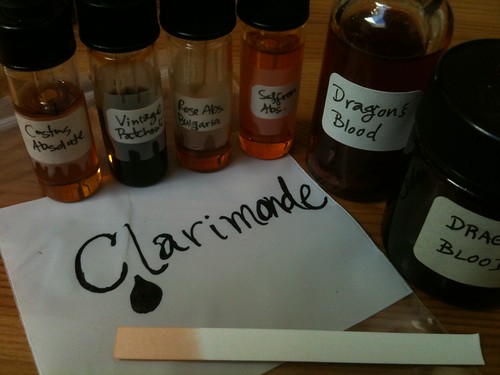
I have included in my packages to the 6 writers covering the Clarimonde project, also a perfume that is unfinished and is what I used for scenting the Clarimonde dream pillow – except that it is in an alcohol form and with the addition of angelica, orris root and liatrix (which is present in the pillow, but not in the essences used to scent it). I’m debating if to add any lavender to the perfume; so far I like how bold and clear the perfume is, and how it’s such a strong characteristics oriental, but with the emphasis on violet, which normally is more prominent in prim floral bouquets and soft powdery concoctions.
To fully experience the power of this pillow, you must sleep on it, literally. Place it instide the pillowcase of the pillow you use while sleeping, and notice how it transforms your dreams making them more vivid and memorable.
Other Clarimonde posts from participating blogs:
The Clarimonde Project/& Sharif Give-Away
Clarimonde Part 2 - Vintage Perfumes and Heat for the Cold
Monica Miller's letter to Lucy about her Sangre perfume and perfumed lip stains
Perfume Pharmer Review of Clarimonde Dream Pillow
Lost Past Remembered – Deana Sidney: Recipe for a perfumed port with chocolate, ambergris and oud
Immortal Mine
Alexis Karl & Maria McElroy (Geisha M)
Scentless SensibilitiesMandy Aftel's
Oud LubanJade Dressler's blog
Scent Hive:Part 1Part 2 (Oud Luban, Immortal Mine)Part 3 (Paradise Lost, Clarimonde Dream Pillow)



